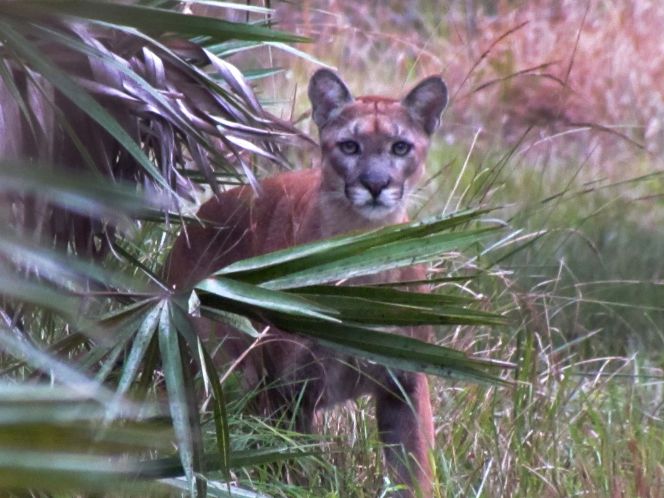The Florida wildlife commissioner who pushed to loosen the state's official panther policy is also part of a group seeking a federal permit to kill a certain number of panthers if they get in the way of plans for their land.
Some of Florida's biggest landowners have spent more than a decade working on this plan, which will set the rules for development on 177,000 acres in Collier County. The land stretches from the Okaloacoochee Slough State Forest on its northern end to the Florida Panther National Wildlife Refuge and Big Cypress National Preserve to the south.
They envision a new town in the middle of panther habitat, along with mining, oil exploration, agriculture and, on some acreage, preservation to benefit panthers. The plan has the backing of some environmental groups but has drawn opposition from others.
If approved by federal officials, the plan would allow what's known as "incidental take" of endangered species in that area, including not only panthers but scrub jays, red-cockaded woodpeckers and Everglades snail kites. Under the Endangered Species Act, "take" means "to harass, harm, pursue, hunt, shoot, wound, kill, trap, capture, or collect" a certain number of those animals.
Among the landowners seeking the permit is Immokalee rancher Liesa Priddy, who in 2012 was appointed to the Florida Fish and Wildlife Conservation Commission by Gov. Rick Scott.
Earlier this year, Priddy urged her agency's executive director to create a new policy for how the state deals with the endangered cats, and then helped him edit it, line by line. The policy they came up with called for easing protections on the state animal. It had not been reviewed by the agency's own panther biologists before it was completed.
The timing of that revision of Florida's panther protections while that incidental take permit is in the works "is troubling to us," Jennifer Hecker of the Conservancy of Southwest Florida said earlier this month.
"Any decision you would make that you would benefit from directly, to me that poses a conflict," Hecker said.
Priddy disagreed.
"I don't have a conflict of interest on anything related to my position on the wildlife commission," Priddy said earlier this month. "Anybody who doesn't agree with the new panther policy is going to find any possible way to cloud the issue."
Last week, the state wildlife agency's director issued a new draft of the policy that omitted the controversial language. The new version, to be discussed in September, now includes input from the agency's scientists.
However, it still calls for federal officials to revise their criteria for taking panthers off the endangered list. The current criteria set a goal too high to be achieved, the draft says.
Meanwhile, though, a scientific study published last month contends that panthers have already lost more habitat than federal and state officials think.
"Because there is less panther habitat remaining than previously thought, we recommend that all remaining breeding habitat in south Florida should be maintained," the authors of the study, "Landscape Analysis of Adult Panther Habitat," wrote.
State officials estimate the current panther population is 100 to 180, far better than the 20 to 30 that were left just 20 years ago. But as the population has expanded, the habitat has shrunk, and the panthers have gone after domestic pets and livestock.
Priddy's JB Ranch has lost at least 10 calves to hungry panthers, according to a University of Florida study, with each panther kill costing her $1,000.
Other major landowners working with Priddy in pursuing the incidental take permit on panthers include two major sugar companies, Alico and King Ranch; the Half Circle L Ranch; Pacific Tomato Growers; English Brothers; and the Barron Collier Partnership and Collier Enterprises.
Barron Collier Partnership and Collier Enterprises have been working for more than a decade on creating a new city — initially called Big Cypress, now nameless — that would put 10,000 residential homes on 4,000 acres of prime panther habitat. The website says the first homes should be available in 2018.
If approved, the permit would create what is known as a Habitat Conservation Plan, allowing development and other human activities to occur on part of it while preserving the rest to make up for the damage done. Some undeveloped private land would be put under a conservation easement, in effect blocking any development from occurring there.
For groups like Defenders of Wildlife and the Collier County Audubon Society, that makes the plan worth supporting.
"We're trying to get some certainty about what that area is going to look like," said Elizabeth Fleming of Defenders of Wildlife's St. Petersburg office.
Approval of the Habitat Conservation Plan would give a green light to all of those plans at once, rather than making the landowners go through separate permitting for each project, which is one reason some environmental groups oppose it.
A draft of the application from 2010 says residential and commercial development across the entire region would be limited to 45,000 acres, but does not specify where that would occur, or what might happen specifically to Priddy's property.
A spokeswoman for the Collier companies said no official would answer questions about the application, and a U.S. Fish and Wildlife Service spokesman said the application is not available for public scrutiny because it's a "predecisional" document. It is just now beginning its review.
Taxpayers helped Priddy and the other landowners pay for creating the Habitat Conservation Plan. In 2012, the Fish and Wildlife Service awarded a grant of nearly $150,000 to aid in "concluding the planning efforts" for it.
But Hecker, of the Southwest Florida conservancy, questioned how the agency could even think of approving it, given how much panther habitat has already disappeared.
"We have no room to lose anything," she said.
Source: Tamp Bay Times, Full Article


